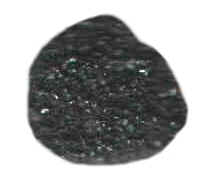|
CHALCEDONY
|
 |
A variety of quartz which is made up of silicon dioxide and is relatively hard (7 on mohs scale). In it's pure form it is milky white/pale grey in colour. However, it occurs in many different forms and colours and is one of the most widespread minerals on earth. The different varieties and colours result from the inclusion of impurities. One such variety is jasper, which derives it's red colour from iron oxides. Chrysoprase is green due to the inclusion of nickel and moss agate contains manganese oxide. Other forms include sard (dark brown), carnelian (red) and bloodstone (green with red spots). The most valuable form of chalcedony is chrysoprase. Some varieties such as agate and onyx have parallel bands running across them once again due to the presence of impurities.
Chalcedony may sometimes be confused with opal. This is itself a variety of quartz. When opal loses it's water crystals that are normally attached it becomes chalcedony. Therefore chalcedony is a dehydration product of opal. The various forms of chalcedony are often used for jewellery and ornaments and may sometimes be imitated by glass.
The word chalcedony is derived from the ancient port of Khalkedon in Turkey where the first deposits were found.
It occurs in the cavities of many forms of rock such as lavas. Much of it is formed from the solidification of silica rich solutions at low temperatures.
Deposits may be found in Bombay but the main producers are Brazil and Uruguay.
|
CHROMITE
|
 |
It is black/brownish black and is the only natural source of chromium. It is made up of iron, chromium and oxygen and measures 5.5 on the mohs scale. It is highly resistant to chemical change and heat and therefore is used as a lining for furnaces making bricks. It is also used as a protective coating for brass/bronze and as a component of stainless steel.
It is an accessory mineral in igneous rocks such as serpentinite where it usually forms in great masses which are large enough to be mined for use in industry. It may also be found in alluvial sands and gravels
Chromite was first mined in the mid 19th century near Baltimore in Maryland (at the Bare Hills). Today it may be found in Albania, Austria, Brazil, Finland, UK (Shetland Isles), Poland, Russia, South Africa and Turkey.
